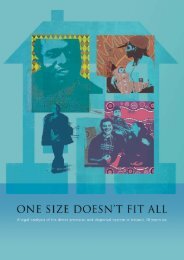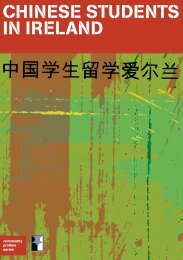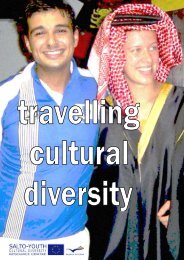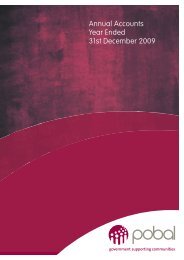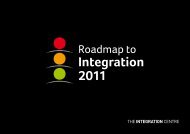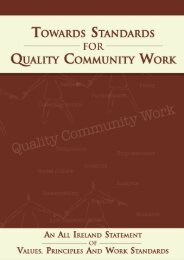Intercultural Education in the Post-Primary School - National Council ...
Intercultural Education in the Post-Primary School - National Council ...
Intercultural Education in the Post-Primary School - National Council ...
You also want an ePaper? Increase the reach of your titles
YUMPU automatically turns print PDFs into web optimized ePapers that Google loves.
Table 4: Asylum Applications <strong>in</strong> IrelandYear1992 401993 901994 3601995 4201996 1,1801997 3,8801998 4,6301999 7,7202000 10,9382001 10,3252002 11,6342003 7,9002004 4,766Dur<strong>in</strong>g <strong>the</strong> 1990s Ireland began to receivea larger share of asylum seekers (Table 4).These asylum seekers came from manycountries <strong>in</strong>clud<strong>in</strong>g Nigeria, Romania,Republic of Moldova, Poland, DemocraticRepublic of Congo, <strong>the</strong> RussianFederation, Algeria, and <strong>the</strong> Ukra<strong>in</strong>e. Inaddition to those who sought asylum <strong>in</strong>Ireland, <strong>the</strong> Irish government has, atvarious times, welcomed groups of peoplewho were flee<strong>in</strong>g persecution, such asthose from former Yugoslav states such asBosnia-Herzegov<strong>in</strong>a dur<strong>in</strong>g <strong>the</strong> period ofgenocide <strong>in</strong> that country, or at a later date,those flee<strong>in</strong>g persecution <strong>in</strong> Kosovo. Thesewere known as Programme Refugees anddid not have to go through <strong>the</strong> asylumprocess. In recent years <strong>the</strong> number ofapplications for asylum <strong>in</strong> Ireland hasbeen decreas<strong>in</strong>g.Simply list<strong>in</strong>g <strong>the</strong> numbers of people and<strong>the</strong> countries from which <strong>the</strong>y come <strong>in</strong> thisway does not fully represent <strong>the</strong> reality ofcultural diversity, which <strong>the</strong>se immigrantsrepresent. A country like Nigeria, forexample, conta<strong>in</strong>s three major ethnicgroups and, perhaps more than 240m<strong>in</strong>ority languages and ethnic groups.O<strong>the</strong>r countries of orig<strong>in</strong> may also bequite diverse.Although <strong>the</strong> recent growth <strong>in</strong> immigrationhas given rise to a greater awareness ofcultural diversity <strong>in</strong> Ireland, it could beargued that Ireland has long been culturallydiverse. One of <strong>the</strong> largest m<strong>in</strong>ority ethnicgroups <strong>in</strong> Ireland is <strong>the</strong> Irish Travellercommunity. There are an estimated 25,000Travellers <strong>in</strong> Ireland, a fur<strong>the</strong>r 15,000 IrishTravellers liv<strong>in</strong>g <strong>in</strong> <strong>the</strong> UK and 10,000 liv<strong>in</strong>g<strong>in</strong> <strong>the</strong> USA. The Irish Government’s 1995Report of <strong>the</strong> Task Force on <strong>the</strong> Travell<strong>in</strong>gCommunity identifies that Travellers are adist<strong>in</strong>ct ethnic group <strong>in</strong> Ireland, but alsoidentifies that this has often not beenfully recognised.It is clear that <strong>the</strong> Traveller community’sculture is dist<strong>in</strong>ct and different. ‘Settled’people generally recognise <strong>the</strong> differencebut fail to understand it as culturaldifference. This is a phenomenon,characteristic of many societies, where <strong>the</strong>majority culture sees itself as hold<strong>in</strong>g auniversal validity or norm <strong>in</strong> relation tovalues, mean<strong>in</strong>gs and identity.Ireland has also long been a l<strong>in</strong>guisticallydiverse society and has two officiallanguages, Irish and English. The island ofIreland is also <strong>the</strong> home of a number ofo<strong>the</strong>r native languages, <strong>in</strong>clud<strong>in</strong>g UlsterScots, Irish Sign language and Gammon orCant (a language historically known to andused by Irish Travellers). Indeed, like manysocieties world wide, Ireland ischaracterised by some degree ofbil<strong>in</strong>gualism. The 1996 Census showedthat, as well as be<strong>in</strong>g speakers of English,43 per cent of <strong>the</strong> Irish population werespeakers of Irish. In Gaeltacht areas, thisrises to 76 per cent. On a national basis,one quarter of those who speak Irish use itdaily. This rises to 60 per cent <strong>in</strong> Gaeltachtareas. For some, Irish is <strong>the</strong>ir first language(usually with English as a second4<strong>Intercultural</strong> <strong>Education</strong> <strong>in</strong> <strong>the</strong> <strong>Post</strong>-<strong>Primary</strong> <strong>School</strong>








